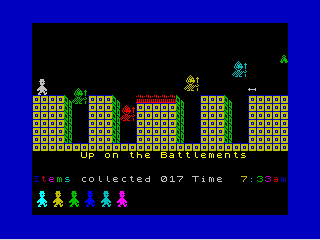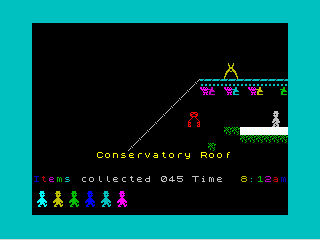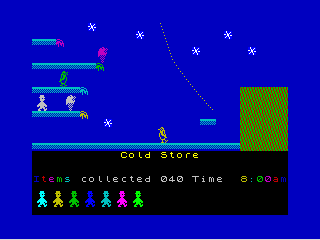If I've learned anything about house hunting, it's that you should always, always pay for a good inspection. Even in a seller's market, do not waive an inspection contingency. Walk away if they try to pressure you into it. Last summer, "D" and I thought we found our dream house, a six-bedroom country estate complete with a beautiful backyard garden and detached guest house. Inspection showed it to be a deathtrap of code violations, malfunctioning equipment, rotting walls, pests, gas leaks, and tip-prone appliances. Sort of like Willy's mansion.
I resumed play from where I had left off before, a saved game in an easy room directly above the gates of hell (see inspection report pg. 20, Foundation/Basement Issues). This time I knew not to drop in and continued eastward to the burrow under Willy's driveway, and found getting out to be much easier once I realized that a conveyor belt which seemed to be moving right was in fact moving to the left, toward the way out.
Emerging up onto the surface of Willy's driveway, I went back to the left, where my path converged back into "The Security Guard," only now on an upper level. I do like it when these semi-linear worlds interconnect like that.
 |
| Passing over the sentries is somewhat harder than passing below them was. |
The next few rooms were surprisingly doable compared to the multiple nightmarish rooms I slogged through in my first run. The stairs led up to Willy's front door, from which I entered a hall with some spike traps to jump over while avoiding a single overhead duck, leading into a ballroom with some slow-moving and easily dodged spiders. A ladder here went up to a trickier room titled "East Wall Base" where a faster moving spider and a deadly-for-some-reason scroll vertically patrolled a series of narrow ledges, and after successfully navigating those, a nasty room awaited above.
What makes this room so nasty isn't so much the difficulty, nor the demonic imagery (just what do the priests do here anyway?), but the fact that if you fall even once from a slightly misjudged jump - quite possible given the pressure of having to stay a step ahead of the demon skull - you'll probably fall to your death on the room below, which means another endless respawn-and-die loop.
But I did, after a few save-state reloads here, get the bible at the top and continue westward, where after passing through a trivial generator room, a less trivial room with a big snake-shaped corridor, and then the infamous attic, I arrived in the rooftop area above the banyan tree, coming in from the other direction.
 |
| I see a potential Google Doodle here. |
Heading further up, the next few rooms above the roof were pretty tricky, but nothing unmanageable with a save state every room or two. One room named "Nomen Luni" had a bird, an alien, a robot, and a moon moving around in simple patterns, more or less spaced out so that only one would be a problem at a time. The next had a swinging rope over a conveyor belt where a single dancing rabbit guarded a collectable sword embedded in the wall, and here I figured out the rope controls; move in the direction of the rope's velocity (not its orientation) to climb down, and against it to climb up. Afterward, a room "Up on the Battlements" had me dodge stray arrows while jumping across sentried parapets, one such jump made aggravatingly difficult by a conveyor belt on the preceding parapet, making it trial and error to figure out the exact timing needed to jump onto it and then be able to hop over the next crenelation without touching the sentry.
 |
| Not shown - at least a dozen failures |
Another room eclectically named "We must perform a Quirkafleeg" was otherwise uninteresting, having nothing but a rope swinging over a spiked portcullis, and a stray arrow that kills you almost immediately if you don't enter the room jumping for it. I had actually gotten to this room before by accident, by clipping through the ceiling in the room below it, which of course killed immediately me as I was now touching the portcullis and had put the game into one of its infinite death loops. The rope, however, could be climbed to the top and into a secret watch tower.
This room may look simple, but cramped space combined with your inflexible jump trajectory makes it one of the hardest I've seen since the last session. You have to jump to grab the apples without touching the vines they sit on, and the enemies make things even worse for you. Falling from the tower is, of course, a death loop condition.
The rest of the rooftop rooms are comparatively trivial. There's another battlement room named "I'm sure I've seen this before," made much easier than the first one thanks to the removal of the conveyor belt. There's a "Rescue Esmeralda" room that riffs on Ocean Software's Hunchback but merely features two spear-wielding guards moving up and down some crenelations and a slow-moving duck flying overhead that you just need to be patient enough to not jump into. The final room has a flagpole with a collectable tip that you can just run up and take - touching the flag itself is deadly, and falling here is a death loop, but once you know that, you couldn't die here unless it was on purpose.
"Rescue Esmeralda" exits downwards to the generator room, from where I traveled back to the rooftop, and then westward to more unexplored rooms. A "Conservatory Roof" tantalized with multiple seemingly inaccessible objects, and a staircase down led to an orange grove, where two oranges could be taken, but a third one was out of reach.
 |
| Falling here = death loop |
Further west, the roof above the west wing held some more objects. Heading down the stairs and out the back door, I landed on a beach.
 |
| Deceptively hard. The crabs (are those crabs?) are much wider than they look, and your hurtbox width changes with your walk animation cycle. |
Willy's yacht was moored here; a two-room navigation puzzle of middling difficulty. It doesn't lead anywhere, but contains a few more items to collect, so I returned home, picking up a spare hammer in the toolshed by the back door, which would have been trivial to collect if it weren't for limited lives.
 |
| Fall down and die to grab it and respawn. Or take the hard route down, climb back up, and face a nearly impossible platform jump on the return route thanks to that hanging nail. |
The cold storage room that I stumbled into during my first session was just off the back staircase, and its ice crystals seem impossible to collect without dying or using several save states.
Further to the right were the kitchen rooms, where I easily ascended a series of platforms patrolled by angry cooks and emerged in a previously inaccessible grotto under the Banyan Tree containing an item. I re-ascended the tree to a vantage point from which I could access the previously inaccessible items in the orangery and conservatory roof.
 |
| One of which seems to be impossible to get without dying. |
The west end of the mansion seemed pretty thoroughly cleaned, so I headed to the east side of it, picking up a few objects of low to middling difficulty in some rooms near the middle on the ground floor. Heading out the door and past the driveway, I found myself beneath a "MegaTree."
As usual, completing any of these rooms in your first few tries is damned near impossible, and getting enough practice to do it consistently seems just as unlikely.
 |
| Touching the vines here kills you. |
 |
| Touching the leaves will kill you. |
 |
| Seriously, how? |
 |
| Ok, this one's kind of chill. |
 |
| That one was kind of unfair. Also, falling here is a death loop. |
After clearing this miserable area, an effort that took me five save states to pull off, I continued past the tree to the right, jumped over a bridge, and entered the eastmost room of the game, featuring a plethora of objects and no clear way to get them all without dying.
This close to the end it didn't really matter. Only one room remained to be explored, and it was pretty close to the start. The mansion's chapel awaited off the first floor landing, which I backtracked to - a nontrivial task even with it being familiar grounds, and without having to worry about collecting items on the way! This room, featuring more occult imagery, was basically a timing puzzle, as the stairs force you to walk to the top and possibly into the demon skull at the top if timed poorly.
Finally, with 83 items collected, Maria allowed me into the master bedroom, triggering Jet Set Willy's shocking twist ending.
GAB rating: Bad. If Manic Miner was a chore to play, Jet Set Willy was torturous. I like a challenge, but I didn't have a moment of fun slogging through these punishing rooms over and over again, and that was with a lax policy on save states, of which I needed exactly 42 to make it through JSW's 60 rooms. Surprisingly, the toughest rooms of all were encountered early on - I'd say that The Nightmare Room and The Forgotten Abbey were the hardest.
It's a pity too, because Jet Set Willy has something going for it. The non-linear mansion design is inspired. Its interconnected map layout anticipates one the defining properties of Metroid-style games to come, coming together in a more complete and sophisticated way than Pitfall II did the same year, and authorial design shows throughout, even if Smith's authorial design only amounts to silly non-sequitur sight gags. Willy's Mansion is just as much of a fully realized game world, if not as logically consistent, as Dracula's castle in Symphony of the Night. But Smith's player-hostile design, with unending and impossibly narrow gauntlets of enemies and obstacles, its devil-may-care attitude toward its own bugs (never mind the literal game-breaking bugs that they had to fix via magazine cheat codes, its cheap random-feeling deaths from stray arrows and invisible hazards, and its patently inadequate spare lives and its infinite death loops that will drain them all in one bad fall all but ensures that nobody will see very much of it without some hardcore cheating.
Jet Set Willy reminds me a lot of I Wanna Be the Guy, a notorious platform hell that I've alluded to before with Jumpman. JSW resembles it even more strongly, and its DNA almost certainly propagated to that game, as it directly references Monty on the Run, a similarly structured platform adventure which was also originally designed for the ZX Spectrum. I Wanna Be the Guy entertains where JSW only aggravates, for a number of reasons, as does Jumpman.
First, the sheer variety of ways both games can surprise and screw you over far outnumber Willys', and that combined with a better sense of comedic timing makes it amusing to lose. Jet Set Willy only irritates and bores with its repetitiveness.
Second, once you have these tricks more or less memorized, IWBTG and Jumpman emphasize dexterity over pixel-and-frame-precise jumping. This is both more entertaining and more empowering, as you feel more in control, and therefore more at fault when things don't work out.
Third and most importantly, these games don't expect you do do everything in one sitting, unless you play IWBGT in its impossible mode (or Jumpan in Grand Tour mode). Death doesn't make you repeat the entire game - IWBGT has checkpoints, while Jumpman lets you start on the intermediate and expert floors without having to re-beat everything before them. JSW does whenever you run out of lives, which can happen for no shortage of reasons, whether fair or unfair.
To that end, I think Jet Set Willy would have been salvaged if it had built-in checkpoints that replenished your stock of spare lives and restored you when you ran out. The infinite death loops would have to go as well - perhaps best done by respawning Willy not always in the room where he died, but at the start of the last one where his feet touched solid ground for more than a few frame cycles.
Jet Set Willy is among the most famous and popular British 8-bit games. Its direct influence is seen not just in the aforementioned Monty, but also in the long-running Dizzy series which went in more of an inventory puzzle direction. Hacked copies with custom maps are just as popular on the ZX Spectrum as custom level sets for Boulder Dash are on the Atari 8-bit and Commodore 64. I like to think that this massive mansion, most of which you'd never come within spitting distance of thanks to its insurmountable and unforgiving difficulty, led some mystique to British gamers in the day. Or maybe they just cheated even more than I did? I don't know, but I'm done with this series. Jet Set Willy II: The Final Frontier builds on the original mansion design making it even bigger, but was done without Matthew Smith's involvement and doesn't make whale status.






























